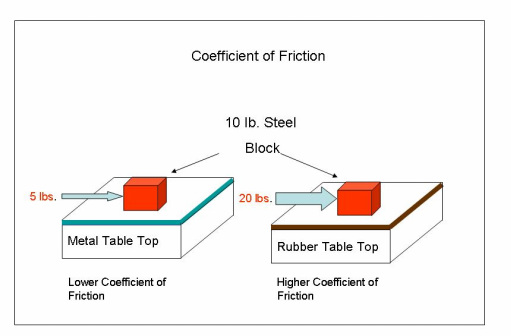|
|
|
|

Title: Coefficient of Friction
Describing the Principle: The term coefficient of friction is an important concept in the design of clutch systems, braking systems, and tires. It is defined as a measure of how much friction is produced from the movement between different materials. Some materials are very smooth and offer little resistance, while other materials may be rough and produce greater resistance. For example, metal against metal may produce little frictional resistance, while metal against rubber may produce greater frictional resistance.
Refer to the illustration to the left. There are two table tops, one metal and one rubber. A 10 lb. block of steel is placed in the center of each table. On the left table it takes 5 lbs. of force to move the 10 lb. block across the metal table. On the right table, it takes 20 lbs of force to move the steel block across the table. The rubber table top has a higher coefficient of friction then the metal table top. Relating this to clutch, brake, or tire materials, higher coefficients of friction mean that more load on the material is needed to cause it to slip. Think of a tire for example. The coefficient of friction between the tire and the road needs to be very high. If not, the tire may slip easily on the road, possibly causing an accident.
There are many materials that have high coefficient of friction characteristics. Such materials are also designed to dissipate heat more rapidly. During the movement of the 10 lb. block of steel in the above illustration, kinetic energy has been converted to thermal energy. Materials with high coefficient of friction and good heat dissipation characteristics are often made from organic and Kevlar composites, bronze, metallic and sintered iron, and other composite materials.
Back to Mechanical Principles
Describing the Principle: The term coefficient of friction is an important concept in the design of clutch systems, braking systems, and tires. It is defined as a measure of how much friction is produced from the movement between different materials. Some materials are very smooth and offer little resistance, while other materials may be rough and produce greater resistance. For example, metal against metal may produce little frictional resistance, while metal against rubber may produce greater frictional resistance.
Refer to the illustration to the left. There are two table tops, one metal and one rubber. A 10 lb. block of steel is placed in the center of each table. On the left table it takes 5 lbs. of force to move the 10 lb. block across the metal table. On the right table, it takes 20 lbs of force to move the steel block across the table. The rubber table top has a higher coefficient of friction then the metal table top. Relating this to clutch, brake, or tire materials, higher coefficients of friction mean that more load on the material is needed to cause it to slip. Think of a tire for example. The coefficient of friction between the tire and the road needs to be very high. If not, the tire may slip easily on the road, possibly causing an accident.
There are many materials that have high coefficient of friction characteristics. Such materials are also designed to dissipate heat more rapidly. During the movement of the 10 lb. block of steel in the above illustration, kinetic energy has been converted to thermal energy. Materials with high coefficient of friction and good heat dissipation characteristics are often made from organic and Kevlar composites, bronze, metallic and sintered iron, and other composite materials.
Back to Mechanical Principles
|
|
|
|